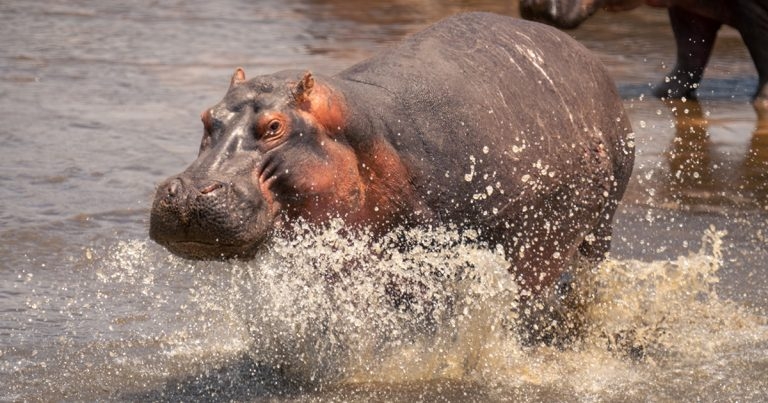8 Jul 2024
New research from the RVC has shown that hippos can get airborne when moving at high speeds.

Image © Nick Dale / Adobe Stock
Researchers have shown that hippos are lighter on their feet than first thought after filming the two ton giants getting airborne when moving at high speeds.
A team from the RVC conducted a study into the movement and gaits of hippopotamuses on land, which found that while they almost exclusively trot, the fastest-moving hippos can become airborne for substantial periods of time.
It is hoped the research, which used video footage of the giant mammals at Flamingo Land Resort in Yorkshire, will improve scientific understanding of how the size of large animals influences their movement on land.
Researchers also believe their work can help support ongoing efforts to reconstruct the evolutionary biomechanics of hippo lineages and help vets diagnose or monitor hippos that have problems moving or are experiences lameness.
Previous studies have claimed hippos often use a standard quadrupedal walk, with a footfall sequence of left hind, left fore, right hand, right fore – similar to elephants; whereas other studies have claimed they trot with their diagonal feet in synchrony.
Prior research also hadn’t established if hippos become airborne when they move quickly, as is the case with many other mammals, such as horses, but less common among larger animals.
John Hutchinson, professor of evolutionary biomechanics at the RVC, and former RVC undergraduate student Emily Pringle led the team, which collected footage from Flamingo Land and footage from the internet to analyse 169 cycles of motion from 32 different hippos.
Analysis found that hippos almost exclusively trot – even when slowly walking or quickly running – and that the fastest-moving hippos become airborne – sometimes for substantial periods (about 15% of the stride cycle, or 0.3 seconds).
The findings from this study broaden the scientific understanding of what giant land animals can do and demonstrate considerable diversity in how they move. Elephants never leave the ground with all four feet, but can still run and rhinos use the same breadth of gaits that smaller land animals can, while hippos can trot and be airborne – pushing the apparent limits of what giant land animals can do.
Prof Hutchinson said: “Our study was about as simple as biomechanics research can get. Anyone can take a camera or internet videos and learn something about how animals move from that footage.
“It’s hard to work with hippos as they tend to stick to the water, and very seldom are trained to be studied in zoo collections. They’re also very dangerous. That’s part of the reason why science knew little about how hippos move before our research.
“We’re thrilled to provide the first study purely focused on revealing how hippos walk and run. We were pleasantly surprised to see how hippos get airborne when they move quickly – it’s really impressive.”